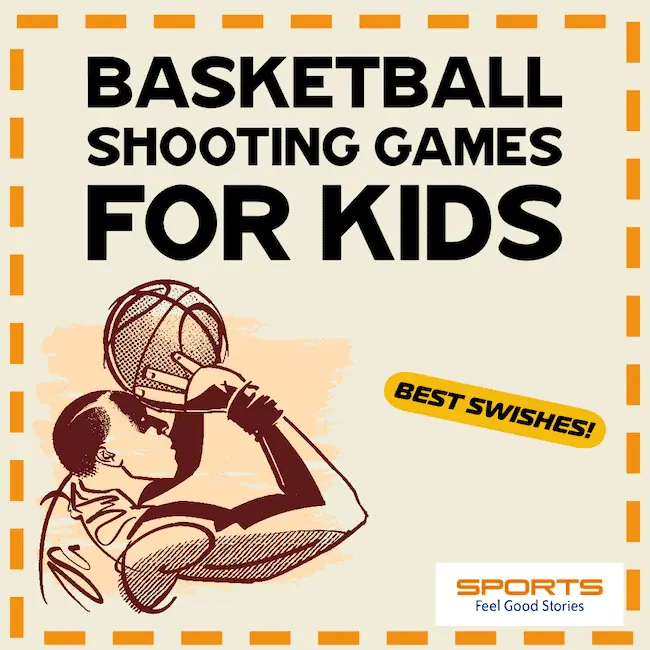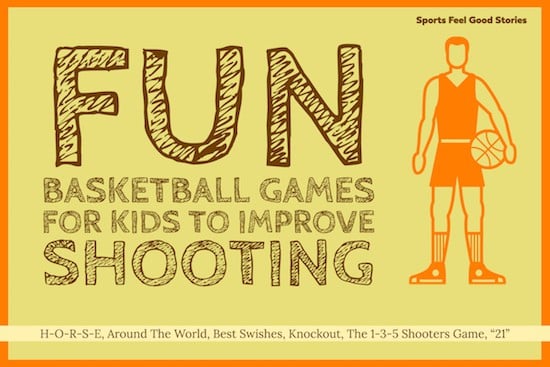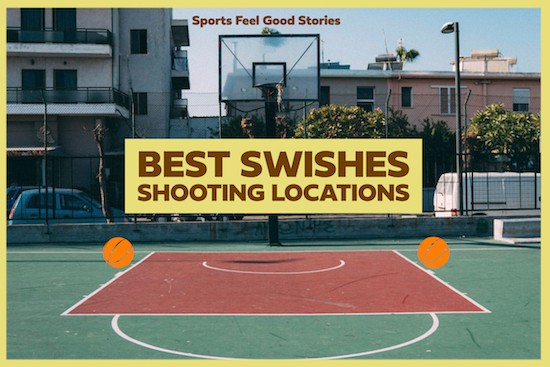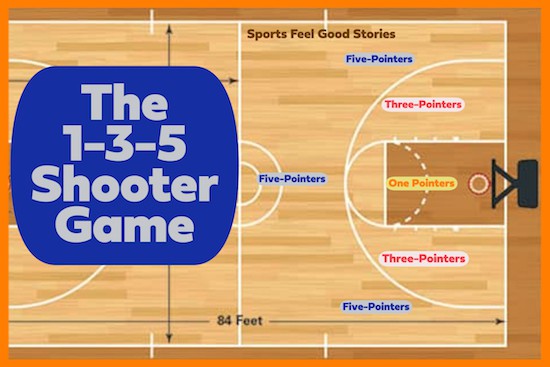Fun basketball games for kids to improve shooting are practice favorites. They can improve a player’s shooting touch, make the sport more enjoyable, and encourage players to practice more enthusiastically.
Mike O’Halloran, a basketball coach with 15 years of experience and author of four books on youth basketball coaching, including Layups and Life Lessons: 101 Coaching Tips For Youth Basketball, shares his favorite shooting games for younger players.
One of the great things about most of these games is that they can be played with just one player. You can play them on the family driveway, at your local park’s hoop, or at organized youth basketball practices.

Introduction to Basketball Shooting Games
One of the biggest challenges for youth basketball coaches is keeping practice time fun for the kids while still providing a valuable learning experience.
Kids learn the game of basketball through repetition. However, if you’re constantly doing the same thing repeatedly, things can get boring quickly. To address that, it helps to shift the content you’re covering every 10 minutes, introduce some competition, and have fun while doing it.
Don’t work on one aspect of the game for one hour at a time. Instead, move quickly from one exercise to the next, e.g., start with a dribbling exercise, move to a shooting skill game, and then to rebounding practice. Teaching in bite-size chunks keeps things fresh and the players interested in learning more.
Players need to understand the proper shooting form for all of these shooting games. With the correct shooting form, games like these reinforce good shooting habits. As players mature, it’s easier for them to shoot the ball with the proper form. So if an eight-year-old’s shooting form doesn’t resemble Steph Curry’s yet, don’t sweat it. Teach and reinforce the basics; over time, players’ shooting form will improve.
1.) Around the World
This is a shooting game where players compete by shooting from 7 selected spots on the basketball court. Select spots within a player’s shooting distance, e.g., for 12-year-olds, shots are within a 12-foot to 18-foot distance.
The game’s goal is to move “around the world” in a counter-clockwise direction by making shots from the first spot to the last spot.
To start the game, the first player shoots from the first spot. If the player makes the basket, the player moves to the next spot. If the player misses the shot, the player can call “Chance.” And if the player misses the second shot (the Chance shot), she moves to the end of the line, and the next player starts their turn shooting.
For the early spots, “chancing it” is a common strategy. But as you progress and make shots from a few spots, players are faced with the dilemma of knowing that a missed shot will wipe out their progress. Not chancing it and staying in place keeps your progress but forces you to give up your turn.
The first person to successfully make all their shots from the selected spots wins the game.
Number of Players
1 – 10+
Variations
- Around the World and Back: Players must make all of the shots in one direction and then repeat the shots in the other direction.
- Add a more difficult shot for the last shot of the game, e.g., a three-pointer.
- Reduce the number of shooting spots from seven to five.
See our Fun Basketball Signature Moves.

2.) The Mikan Drill Game
Named after “Mr. Basketball” George Mikan, this game calls for players to shoot layups off their inside foot with their outside hand alternating sides of the basket for 30 seconds. The goal is to make the most baskets in that amount of time.
For younger kids, allow them to shoot off of both feet. This is a great game to teach rebounding, keeping the ball high under the basket, and finishing layups. If you’re at a court with multiple hoops, assign 2-3 players to each hoop, and while one shoots, have the others count the made baskets. It can also be played by one player in the driveway or park.
Number of Players
1 – 12 players
Variations
- Players can be required to make all of their shots as reverse layups.
- Each shot must be taken off two feet.
- Increase the time to 60 seconds.
3.) Best Swishes
Two players stand opposite each other on opposite sides of the key by the first block (12 feet apart and 6 feet from the goal).
Taking alternative turns shooting the basketball, you receive +1 point if you swish the shot, 0 points if you make it but don’t swish, and -1 if you miss the shot. A swish is defined as the ball going through without hitting the rim.
The goal is to be the first person to reach 5 points or to have a 5-point differential between you and your opponent. So, for example, you could win if you have 2 points and your opponent has -3 points — note the 5-point differential.
Number of Players
2 players — But, if you have multiple hoops in a gym setting, more players could play, e.g., six hoops = 12 players.
Variations
- Players must shoot the opposite hand.
- Move the distance back for each player by three feet.

4.) Knockout
Also known as Lightning, this game is traditionally a player favorite in the under 12 years of age category.
Players line up at the free-throw line. The first two players in line each have a basketball.
The game’s object is for the second player who is shooting to make his shot before the first player makes a shot. A player’s first shot is from the free-throw line, but subsequent shots can be taken from any location. This plays out because if a player misses the first shot, the second shot is usually taken from a few feet away from the basket.
As soon as player one takes their first shot, player two can shoot. To stay in the game, each shooter must make a shot before the next person in line makes their shot.
If the second player makes their shot before the first, the first player is “knocked out” of the game. The winner is the last person still playing after all the other players have been knocked out.
The game creates drama as players compete against each other to make a shot before the next player in line can make theirs. In addition to teaching shooting skills, it works on poise under pressure.
Number of Players
2 – 10+ players. It usually works best with 4 – 10 players.
Variations
- Any shot that hits the backboard counts as a miss.
- Follow-up shots must be completed with the player’s opposite hand, e.g., right-handed players must make with left-hand.
5.) H-O-R-S-E
To begin playing for Horse, players decide on the order of shooting, e.g., from youngest player to oldest player, or by calling out “First,” “Second,” and so on. They can also play multiple games and take turns going first.
The first player designated to shoot can shoot from anywhere on the court or off the court. If that player makes the basket, the second player must attempt to make the same shot.
If the second player makes the basket, it goes on to the third player. However, if the second player misses the shot, that player earns a letter. If it’s the first miss, the player will earn an “H.” At that point, the third player can shoot from anywhere. This pattern continues until only one player earns five letters spelling out HORSE.
Part of the fun of this game is that in addition to the spot of the shot, the shooting player can also make designations before shooting the shot. For example, a shooter might designate, “This must be made off the backboard” or “You must shoot with your left hand (off-hand).”
Number of Players
2 – 6 players. It usually works best with 2 – 6 players.
Variations
- Not enough time to play a full game of H-O-R-S-E, shorten the game by playing P-I-G.
- Punish players who take too easy shots. If everyone down the line makes the shot that the first player did, the first player earns a letter.
6.) “21” Game
This is a shooting game where the first player starts by shooting from the free-throw line. If the player makes the free-throw attempt, the player earns one point and shoots again from the free-throw line.
If the free-throw attempt is missed, the player must hurry to grab the rebound. The player shoots from where the rebound was retrieved. If that shot is made, the player gets two points. Then, the second player begins their turn by starting at the free-throw line. Play continues in this pattern.
The first person to score 21 points wins!
Number of Players
It works best with 5 – 12 players but can be played with two or more.
Variations
- Players must score 21 exactly. If they exceed that number, they go back to 13 points.
- Limit the number of free throws made to three. After three free throws are successfully made by one player, the shooting player is defended in one-on-one style play. If the shooting player makes the shot going against the defender, they receive two points plus the right to return to the free-throw line.
- No Backboard Shots: All shots cannot hit the backboard first. If a shot hits the backboard first, count it as a miss and continue on.
- Move shots from the free-throw line to the 3-point line (best for older kids).
Note: Do you have fun basketball games for kids you’d like us to share? Would you please let us know via the contact page?
7.) The 1-3-5 Game
Players are challenged to earn as many points as possible in 60 seconds of shooting. Here is how points are earned:
- One point: any shot made in the paint except for layups.
- Three points: Any shot made outside the paint but not at a three-point line distance.
- Five points: Any shots made from beyond the three-point line.
The non-shooting player(s) keep a running tally of the points accumulated so the shooter knows.
Number of Players
2 – 8 Players.
Variations
- Double the score if you make any of the shots with your off-hand. For example, a right-hander who makes a three-pointer left-handed gets 10 points!
- Shorten the three-point and five-point shooting distances for younger players.
- Add this rule to the game: No two shots can be made successively from the same spot.

8.) The Baker’s Dozen Lay-up Game
Divide your players into two groups. Each group starts at a different hoop. The goal of each team is to make lay-ups, with one point award for each made shot, until the first team reaches 13.
The first time down, the first player dribbles with right-handed if on the right side and left-handed if on the left side and does a running lay-up off the correct foot. Players rebound their own shots, dribble down the same side of the court, now using their other hand, and complete another running layup. The next player in line grabs the rebound and begins the same process of dribbling down to shoot as the first player did, grabbing the rebound and returning.
This process continues until all players have gone down both ways and shot running layups using both hands.
The second time down, players execute a jump stop shot off two feet using the backboard instead of shooting a running layup. They return down the same side of the court, this time dribbling with the opposite hand used the first time down and again shooting a jump-stop layup.
When the first team scores 13 baskets, they win.
Number of Players
Works best with an entire team of players – 10 to 12 – and a full court.
Variations
- Extend the shot length from a layup to an 8-footer or extend the shooting area to the elbow area of the paint.
- Instead of dribbling straight down the court, have the players execute a reverse dribble at half-court every time they hit the half-court line with their dribble. The coach and assistant can stand at the half-court line, so dribbles are forced around them.
We hope you enjoyed our collection of fun basketball games for kids. The more fun kids play the game, the more likely they’ll want to return for more. Anatole France once wrote, “90 percent of education is encouragement.” Encourage more; criticize less.

By Mike O’Halloran
Founder and Editor, Sports Feel Good Stories
Overtime
You’re on the Fun Basketball Games For Kids To Improve Shooting page.
You might like:
Best Instagram Captions for Basketball Photos
